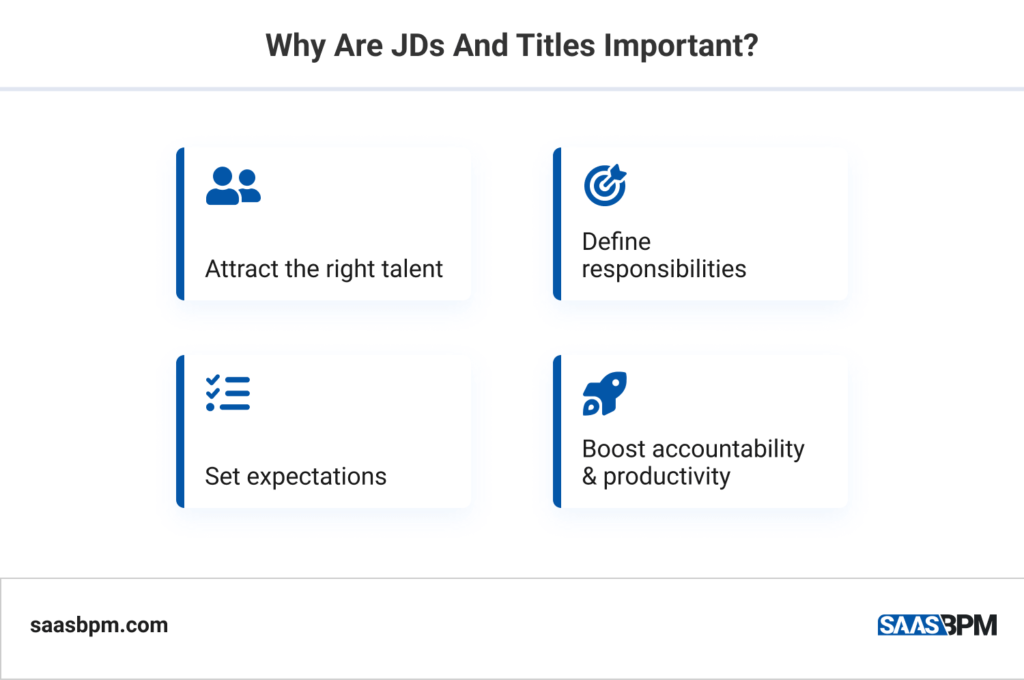Job descriptions and titles have always been a part of the candidate sourcing and recruitment process. To stand out in a sea of similar-sounding jobs, every word in the job description counts.
As the world bounces back from the pandemic, businesses have become more agile. The sudden transition to a remote work model has shifted our thinking to flexible mode. As a result, teams have accustomed to taking responsibilities that haven’t been in their job descriptions before but are a requirement now.
In this article, we will first explain why job descriptions and titles are important. After that, we will go through some of the advantages and disadvantages of keeping them. Then, we will have a look at the present situation of 2022 and the future of work.
Why Are Job Descriptions And Titles Important?
Job descriptions and titles have been around since the advent of jobs, but they are often put off. Of course, there is more to a good job description than meets the eye. You might be surprised by how much your workplace can improve with just an editing pass through its standards-driven recruitment copy.

Job titles in a modern workplace should be enticing and accurate. After all, they are the first impression your company makes to potential talent. A well-written, catchy title will make it easier for people who qualify to click through and apply for the opportunity.
Make sure you include keywords in all of these titles so potential applicants know what type of work you advertise. This way there won’t be any confusion about how applications should look like (i e including relevant experience).
A lot of people may think that job descriptions and titles don’t matter, especially in a virtual setting where roles are fluid. However, this could lead to a lack of understanding about the true value of a clear job description and title. Mind you, they need to reflect one’s responsibilities and expectations.
Firstly, the purpose of a job description and title is to recruit appropriate talent for a specific role. This way you can ensure the right people apply for an open position. When you clearly specify qualifications and requirements, it will be less likely that unqualified applicants try out. This in turn will save you a lot of recruitment headaches by improving application quality.
In addition, job descriptions and modern job titles with a clear structure serve to guarantee accountability and productivity among your employees. Especially for a performance evaluation, a well-written job description can help employers maintain accountability to a position’s needs and demands from employees.
If a job description is vague or open to interpretation, it will be more difficult for an employer to address poor performance. On the contrary, when employees know what you expect, they are more productive and enthusiastic.
Job Descriptions And Titles: Pros And Cons

Job descriptions are a way to ensure that employees know what they’re expected to do, but they can lead to disagreements. They can be a great way to recruit good new employees, but they do have their limitations.
Some think that job descriptions and titles are fundamental to state where the role stands in the organization hierarchy. Others such as millennials believe that these are obsolete and the skillset and agility are more important to putting a position in a certain frame. Here are the main advantages and disadvantages about job descriptions and titles:
Advantages
A job description helps to identify employees that are a good fit. An in-depth job description and a descriptive job title in a modern workplace can help attract the right talent. This way potential candidates will be able to compare their expertise against these requirements and save your HR department some time. You’ll also be able to take advantage during screenings when looking back at the job spec. When you want to evaluate an applicant’s performance, you can use the guidelines they accepted when taking up the position as your back-up.

Job descriptions and titles help employees know their tasks so they can be most productive for the company. They are like short, clear instructions for what each team member needs to do. If you implement the job responsibilities in a BPM software onboarding project, your employee will know the exact steps to complete to successfully manage their workflows and communications.
Another important argument for job descriptions and titles is that they give ground for employees to negotiate a promotion. Usually, these documents set the position within the team structure and show what the consecutive steps are to get to a senior role. Also, many job specs include base salary as well. This, together with the title you acquired may be a good way to convince your next potential employer that you are worth more than the initial offer.
In addition, job descriptions and titles boost retention and satisfaction across team members. If a job description is accurate, the candidate will be more likely to enjoy their job. Therefore, it is crucial to put forward an accurate job description when interviewing potential employees. If you do so, then there’s no way for them not to appreciate their work. Also, they will feel loyal towards your company–and that means higher retention rates!
Disadvantages
The way we define and assess professional success is changing. To many, job titles are not as important as they used to be. In fact, some people are starting to view them as outdated. Job descriptions and titles may be restrictive and run counter to the fast-paced agile virtual office post COVID.

Another downside of job descriptions and titles may be that if they are not written well, they could cause disagreements between employees and managers. Sometimes people might object to what job responsibilities are, especially if the descriptions aren’t clear.
Also, you need to constanly revisit and update job descriptions and titles. For example, they may not reflect the skills or responsibilities the team member performs and does well at. Pain points in this process include ever-changing roles in fields like SEO, design, information technology. New programming languages exist but there is still a demand for developers that are well-versed in the foundations.
In addition, job specs and titles only mark up the macro criteria of a role. They do not really give justice to emotional requirements, level of difficulty, stress etc.
Final Words: Job Descriptions And Titles In 2022 – Where Do We Stand?
Job descriptions and titles have been around since forever. They are useful as they outline the role’s responsibilities, expectations, performance standards, salary, position in the organizational hierarchy. However, they may also be quite limiting. This is a result from the fact that the future of work post-COVID leans toward more agile, fluid positions that you need to constantly update. They will still remain important to attract potential talent and demonstrate what the job would be like. Get ready to keep track and remodel job descriptions with SaaS BPM for HR Managers and win the fast-paced game!

